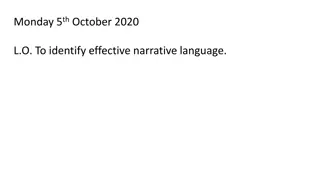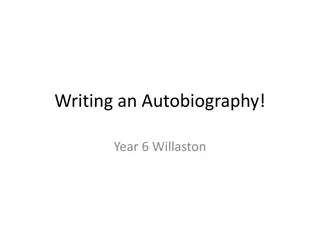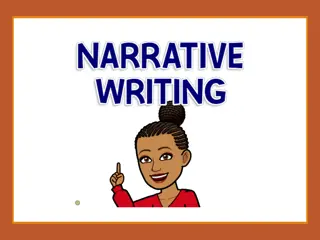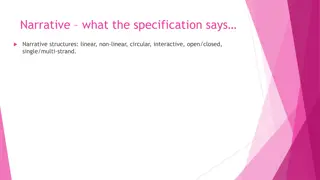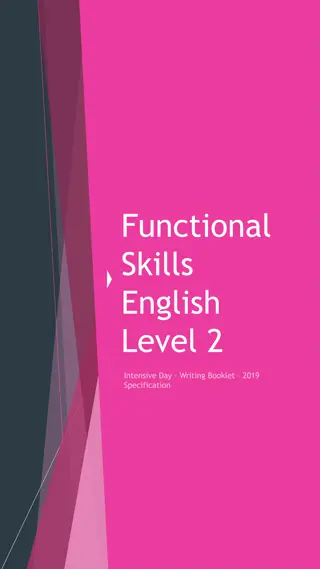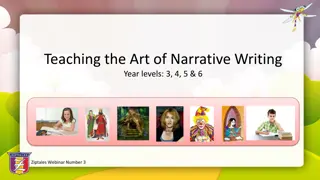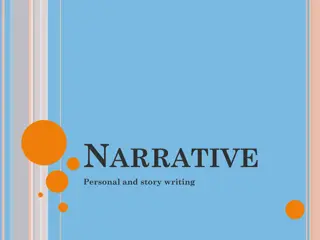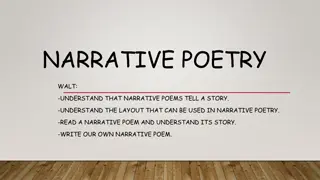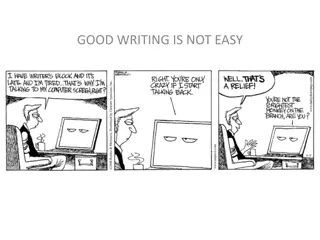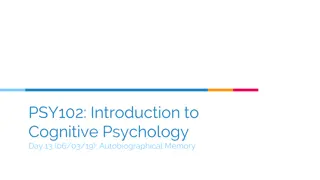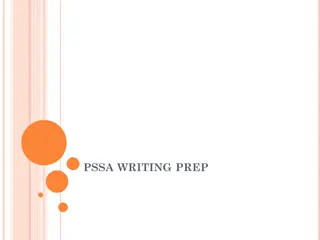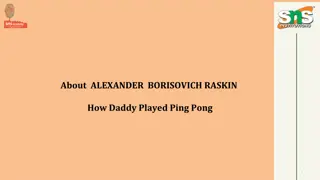Mastering Autobiographical Narrative Writing Techniques
Exploring in-depth strategies for crafting engaging autobiographies using character and setting descriptions, sensory details, and realistic dialogue to bring your story to life and captivate your readers.
Download Presentation

Please find below an Image/Link to download the presentation.
The content on the website is provided AS IS for your information and personal use only. It may not be sold, licensed, or shared on other websites without obtaining consent from the author.If you encounter any issues during the download, it is possible that the publisher has removed the file from their server.
You are allowed to download the files provided on this website for personal or commercial use, subject to the condition that they are used lawfully. All files are the property of their respective owners.
The content on the website is provided AS IS for your information and personal use only. It may not be sold, licensed, or shared on other websites without obtaining consent from the author.
E N D
Presentation Transcript
NARRATIVE WRITING STRATEGIES Writing autobiography is my way of making meaning of the life I have led and am leading and may lead. -Murray
Character and Setting Description Details about what makes the characters and places unique Use exact names specificity is key
Examples of Character and Setting Descriptions Notebook in his lap, pen uncapped, Ian Fraser sat in the dark green Adirondack chair studying the New Hampshire scene that had so often comforted him as he put in his last years at the Washington office. The green meadow sloping unevenly over the granite ledge to the lake and the point of land with its sentinel pine that marked the edge of his possession, and across the lake the hills rising into mountains touched with the reds, oranges, yellows that would flame into autumn this week or next (Murray 62). My father, who was one of the few Indians who went to Catholic school on purpose, was an avid reader of westerns, spy thrillers, murder mysteries, gangster epics, basketball player biographies, and anything else he could find (Alexie 353).
Sensory Detail Information about what the character/narrator sees, smells, hears, feels, and tastes. Connected to memory. Vivid description and detail makes the reader feel as if he or she is really there.
Examples of Sensory Detail In one panel, Superman breaks through a door. His suit is red, blue, and yellow. The brown door shatters into many pieces (Alexie 364). I knew what the tests were asking, but I could not block out of my mind the images already created by the first pair, sunset is to nightfall and I would see a burst of colors against a darkening sky, the moon rising, the lowering of the curtain of stars (Tan).
Realistic Dialogue Bring the characters to life; give them realistic voices. Helps the reader get to know the characters and their personalities. Can advance the action of the story. Scrap unnecessary dialogue. Indented and uses quotation marks.
Examples of Realistic Dialogue And my mother was standing in the back whispering loudly, Why he don t send me check, already two weeks late. So mad he lie to me, losing my money. And then I said in perfect English, Yes, I m getting rather concerned. You had agreed to send the check two weeks ago, but it hasn t arrived (Tan). I cannot read the words aloud, but I assume it tells me that Superman is breaking down the door. Words, dialogue, also float out of Superman s mouth. Because he is breaking down the door, I assume he says, I am breaking down the door. Once again, I pretend to read the words and say aloud, I am breaking down the door. In this way, I learned to read (Alexie 364).
Interior Monologue What the narrator thought silently in his or her mind, but didn t say out loud. Often separated from the rest of the sentence with a comma, instead of quotation marks.
Examples of Interior Monologue His shirt smells like roses, she thought. He killed my sister, she realized with horror.
Tone Humor Verb choice (not too many adverbs) Passive voice ( The man was killed ) vs. active voice ( The bartender killed the man )
Examples of Tone She wouldn t budge. And when the doctor finally called her daughter, me, who spoke in perfect English lo and behold we had assurances the CAT scan would be found, promises that a conference call on Monday would be held, and apologies for any suffering my mother had gone through for a most regrettable mistake (Tan).
Pacing How fast or slow is the story moves in each section. Emphasizes certain parts of the story often through repetition and keeps the reader s interest. Length of sentences.
Examples of a Fast(er) Pace I refused to fail. I was smart. I was arrogant. I was lucky. I read books late into the night, until I could barely keep my eyes open. I read books at recess, then during lunch, and in the few minutes left after I had finished my classroom assignments. I read books in the car when my family traveled to powwows or basketball games. In shopping malls, I ran to bookstores and read bits and pieces of as many books as I could. I read the books my father brought home from the pawnshops and secondhand. I read the books I borrowed from the library. I read the backs of cereal boxes. I read the newspaper. I read the bulletins posted on the walls of the school, the clinic, the tribal offices, the post office. I read junk mail. I read auto- repair manuals. I read magazines. I read anything that had words and paragraphs. I read with equal parts joy and desperation. I loved these books, but I also knew that love had only one purpose. I was trying to save my life (Alexie 365).
Comparisons (Metaphors and Similes) Helps the reader understand how a feeling, place, person, or event is similar to and/or different from something else.
Example of Metaphorical Language Books, I say to them. Books, I say. I throw my weight against their locked doors. The door holds. I am smart. I am arrogant. I am lucky. I am trying to save our lives (Alexie 365).
Talking Directly to the Reader In most stories, the narrator talks to an ambiguous someone. Sometimes, though, the narrator can break through this writer/reader barrier by addressing the reader directly. Maintain the device throughout.
Example of Talking Directly to the Reader I am not a scholar of English or literature. I cannot give you much more than personal opinions on the English language and its variations in this country or others (Tan). So you ll have some idea of what this family talk I heard sounds like, I ll quote what my mother said during a recent conversation (Tan). You should know that my mother s expressive command of English belies how much she actually understands (Tan).
Reflection Explains the significance of the event or experience. Resolution Very important!
Example of Reflection 1 This might be an interesting story all by itself. A little Indian boy teaches himself to read at an early age and advances quickly. He reads Grapes of Wrath in kindergarten when other children are struggling through Dick and Jane. If he had been anything but an Indian boy living on the reservation, he might have been called a prodigy. But he is an Indian boy living on a reservation and is simply an oddity (Alexie 365).
Example of Reflection 2 But [these labels] seemed just as bad, as if everything is limited, including people s perceptions of the limited English speaker. I know this for a fact, because when I was growing up, my mother s limited English limited my perception of her. I was ashamed of her English. I believed that her English reflected the quality of what she had to say. That is, because she expressed them imperfectly, her thoughts were imperfect. And I had plenty of evidence to support me: the fact that people in department stores, at banks, and at restaurants did not take her seriously, did not give her good service, pretended not to understand her, or even acted as if they did not hear her (Tan). I later decided I should envision a reader for the stories I would write. And the reader I decided was my mother, because these stories were stories about mothers [ ] I wanted to capture what language ability tests can never reveal: her intent, her passion, her imagery, the rhythms of her speech and the nature of her thoughts (Tan).


